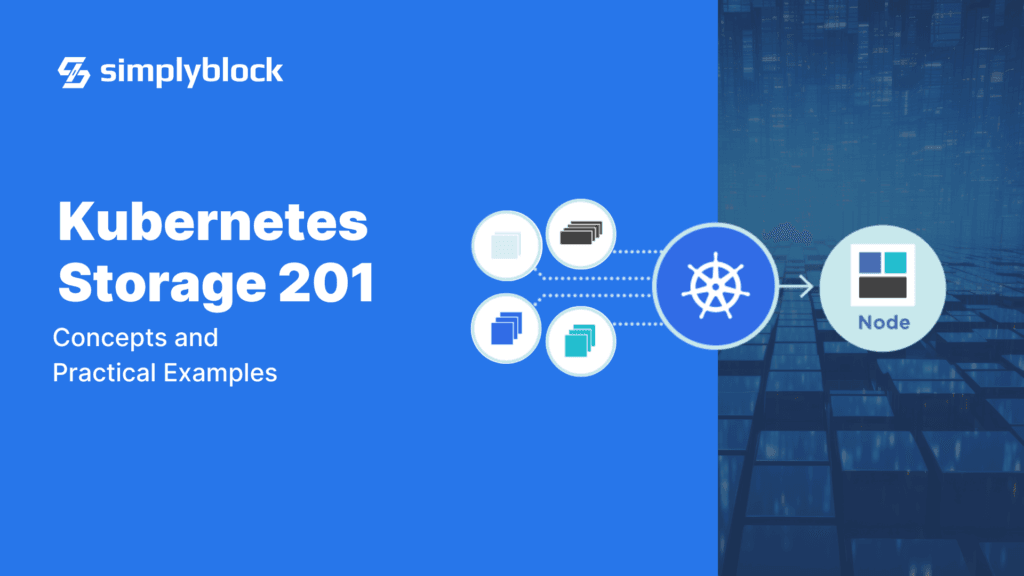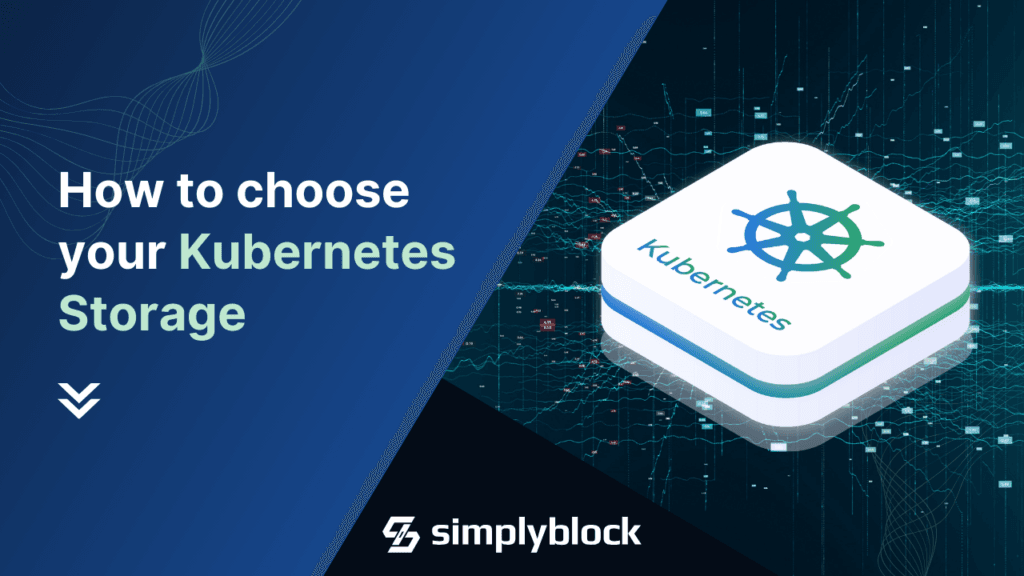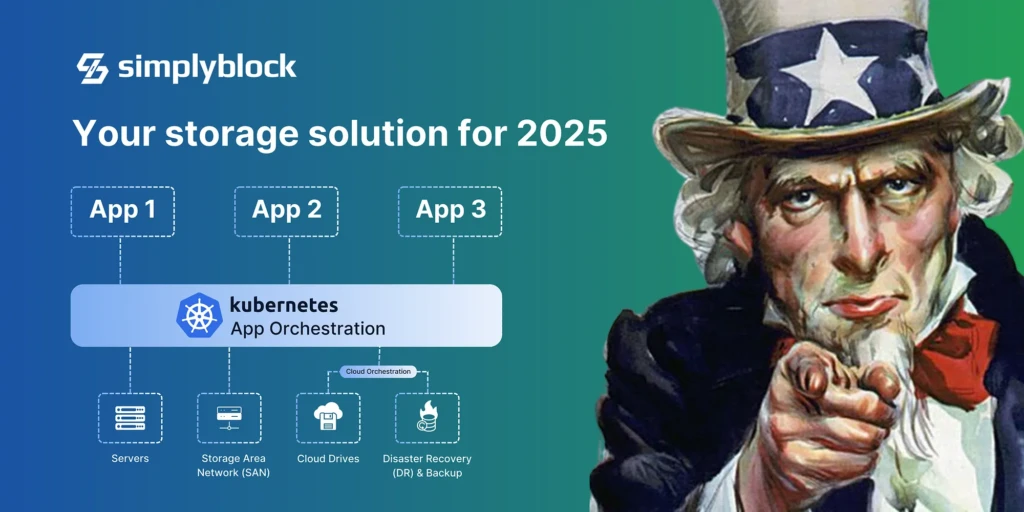Alternative to SAN – Why Software-Defined Storage Wins in the Long Run
Feb 20th, 2025 | 11 min read
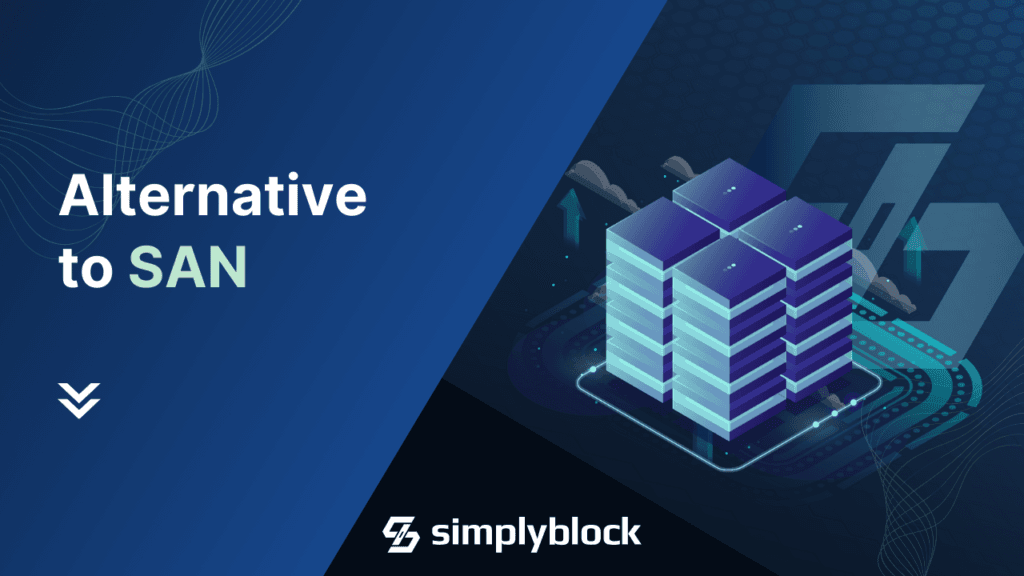
Table Of Contents
- Understanding Day 2 Operations and Lifecycle Management
- Why It’s No Longer About Upfront Costs
- Day 2 Operations: Where NetApp Falls Short of Software-Defined Storage
- Real-World Cost Comparison: NetApp vs. Simplyblock
- Why Simplyblock is the Best NetApp Alternative
- Make the Smart Switch from NetApp to Simplyblock
- Questions and Answers
NetApp has been a dominant player in the enterprise storage market for over two decades, offering feature-rich SAN and NAS solutions but it’s time for an alternative. The landscape of enterprise storage is changing. Enterprises are no longer just evaluating storage solutions based on upfront costs—because traditional SAN vendors, including NetApp, now offer competitively priced hardware, and there are plenty of financing options to avoid significant CAPEX investments.
Instead, the actual financial and operational burden comes from Day 2 operations, long-term lifecycle management, and other overhead, including the extra staffing cost to manage these complex systems. This is where Software-Defined Storage (SDS) solutions like simplyblock truly shine and offer significant flexibility, scalability, and operational efficiency advantages.
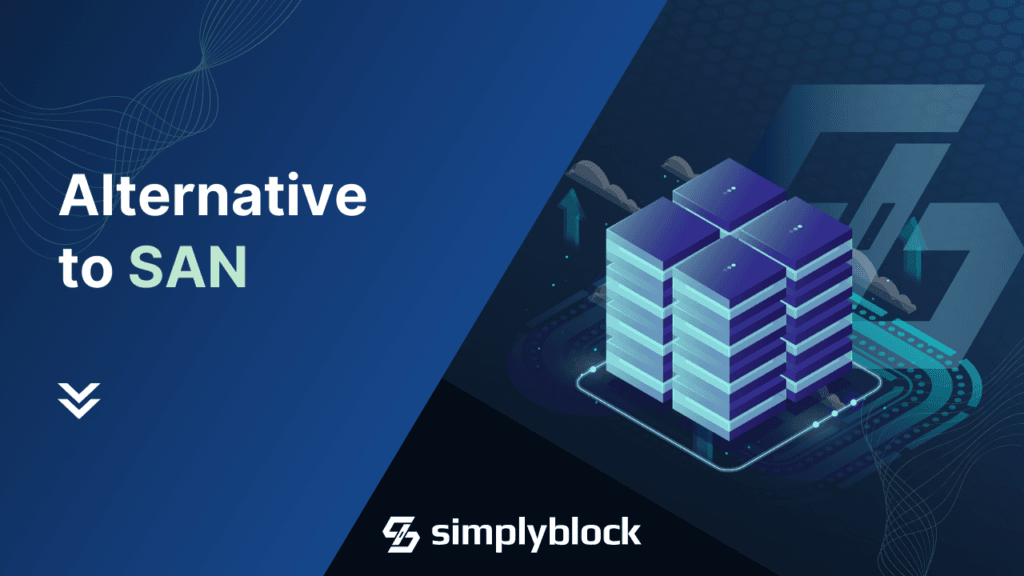
Understanding Day 2 Operations and Lifecycle Management
Day 2 operations refer to the ongoing tasks and processes that occur after the initial deployment of a storage solution. These include:
- Maintenance and Upgrades: Regular updates to hardware and software components to ensure optimal performance and security.
- Scalability Adjustments: Expanding or reducing storage capacity in response to changing organizational needs.
- Performance Optimization: Continuous tuning to meet evolving workload demands.
- Data Migration: Moving data between storage systems or locations without disrupting operations.
- Monitoring and Troubleshooting: Proactive identification and resolution of issues to minimize downtime.
Effective lifecycle management encompasses the entire span of a storage solution’s existence—from planning and deployment to decommissioning—ensuring that the system remains efficient, cost-effective, and aligned with business objectives throughout its life.
While the initial purchase price of traditional storage solutions like those from NetApp may appear competitive, several hidden costs can accumulate over time.
Why It’s No Longer About Upfront Costs
Many storage buyers assume that choosing a NetApp storage system means paying a premium for enterprise-grade hardware and software. However, NetApp and Pure Storage have become more aggressive in pricing their hardware to compete with new entrants in recent years. The problem? The hidden costs of SAN storage emerge after deployment, including:
- Proprietary Hardware Dependencies: Traditional storage solutions rely on proprietary hardware, leading to vendor lock-in and limited flexibility. This dependency can result in higher costs for hardware replacements or upgrades and may restrict the ability to adopt newer, more cost-effective technologies.
- Expensive Software Licensing: Additional features like data replication, tiering, and deduplication often require costly licenses. Access to all enterprise features typically means lots of additional costs on the licensing side, which drastically change initially attractively looking calculations. While paying for great software is fair, SAN vendors’ software stack works only with their hardware.
- High Maintenance Contracts: NetApp’s support and maintenance costs increase significantly over time. It’s hard to foresee these costs upfront. The more problems one has with the system, the higher the support costs. That might not sound like a fair deal to many users.
- Costly Hardware Refresh Cycles: Upgrading and expanding NetApp or Pure Storage systems often involves buying new hardware stacks. While, for example, Pure Storage offers “evergreen” subscriptions where one gets the hardware replacement included in the price, it still means significant interference in operations and personnel overhead every now and then, as the whole system needs to be replaced.
- Operational Complexity: Managing and optimizing NetApp environments requires specialized knowledge, leading to higher admin costs. Is it a good thing that vendor offers certifications to be able to manage their system? In 2025, IT operations should be as simple and as automated as possible. Human involvement should be minimal, but that’s not true with SANs.
Thus, the real reason IT leaders are seeking a NetApp alternative isn’t the initial purchase price—it’s because of the long-term inefficiencies and operational expenses that follow.
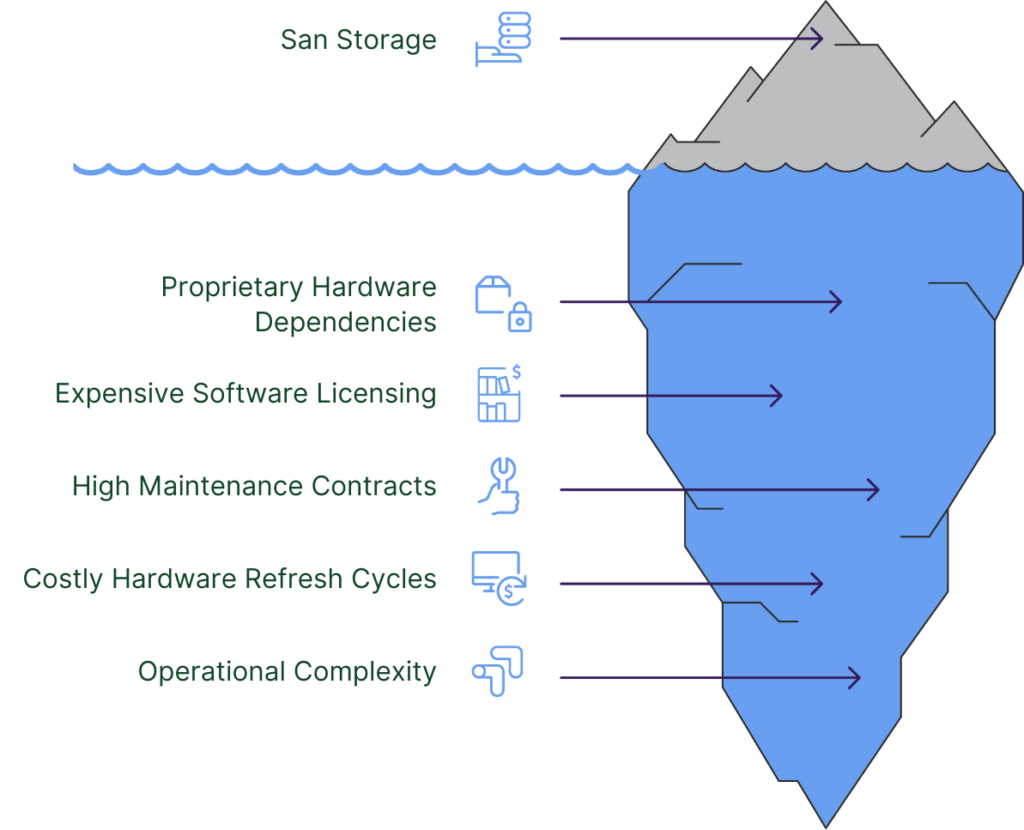
Day 2 Operations: Where NetApp Falls Short of Software-Defined Storage
Once NetApp is deployed, enterprises often experience the challenges of Day 2 operations. This is where software-defined storage (SDS) solutions like simplyblock stand out. SDS is all about scalability, the easiness of hardware upgrades, and simple maintenance. Once the system is set up and online, it can and should stay online forever, regardless of disk, server, or network failures. This is the promise of software-defined storage above all – it’s not just about being able to work with commodity hardware. Let’s look at the advantages of simplyblock over a system like NetApp in more detail.
1. Complexity in Scaling
NetApp’s traditional architectures often require buying more significant controllers or replacing entire systems when scaling. This rigid scaling model leads to expensive forklift upgrades. Systems have a physical limit of scalability beyond which they can’t grow.
🔹 Simplyblock as a NetApp Replacement: Simplyblock offers a complete scale-out architecture that allows organizations to expand storage seamlessly by adding new nodes—without downtime, bottlenecks, or costly hardware overhauls. Simplyblock’s architecture theoretically offers infinite scalability.
2. Software Licensing and Feature Restrictions
With NetApp, enterprise features such as high-availability configurations, advanced tiering, and cloud integration often require expensive software add-ons.
🔹 Simplyblock as a NetApp Alternative: Simplyblock provides enterprise-grade features out-of-the-box with no hidden licensing fees. Features like erasure coding, storage tiering, and automated scaling are built into the core platform—eliminating the need for additional purchases.
3. High Ongoing Maintenance Costs
NetApp storage solutions require costly support contracts for firmware updates, bug fixes, and hardware replacements. Organizations are often locked into multi-year contracts to keep their systems running efficiently.
🔹 Simplyblock as a NetApp Replacement: With Simplyblock’s Software-Defined Storage (SDS) approach, enterprises can choose their preferred hardware, avoiding vendor lock-in and dramatically reducing maintenance costs.
4. Time-Consuming Lifecycle Management
Traditional NetApp systems require frequent manual intervention for upgrades, data migrations, and capacity management, leading to increased administrative overhead.
🔹 Simplyblock as a NetApp Alternative: Simplyblock’s automated management system simplifies lifecycle operations, allowing IT teams to monitor the infrastructure and react in case of hardware failures or reaching capacity thresholds. These tasks do not require special skills or certifications.
5. Lack of Ability to Accurately Estimate TCO
With SAN systems, since there is usually a significant upfront cost involved, one might consider it an “investment” for the future. Nothing is more misleading. That is just the beginning of spending. Additional license costs for new or advanced features, excessive support requirements, or overprovisioning typically lead to higher consolidated spending after the purchase than during the purchase.
🔹 Simplyblock as a NetApp Alternative: with simplyblock, pricing is fully transparent. Not only can you calculate your storage TCO upfront, but you can also get an actual enterprise license where, for a limited period, you won’t have any additional costs. This might feel like a real investment!
6. Dependence on Proprietary Hardware :
SAN vendors often advertise that their hardware is better than the commodity (OEM). However, in reality, they rely on third-party suppliers, as most of the key components of their systems are supplied externally. NetApp or Pure Storage do not produce SSDs. However, rebranding the hardware makes it seem like the disk is significantly different or better from “off-the-market components.” While we can’t deny their R&D efforts and optimization for specific hardware, the real benefits are marginal. Especially when counting the risk of vendor lock-in that it introduces.
🔹By decoupling storage software from hardware, simplyblock allows organizations to utilize commodity hardware, eliminating vendor lock-in and enabling more cost-effective hardware choices. This flexibility simplifies hardware upgrades and replacements, reducing costs and extending the lifecycle of the storage infrastructure. Additionally, the modern OEM hardware is so performant and reliable that there is no need for unique optimization. At least for the vast majority of organizations. If you’re Meta, Tesla, or OpenAI, you might need the cutting edge provided by a single component in your stack. However, if you are not, you are probably already underutilizing your storage and compute resources.
Real-World Cost Comparison: NetApp vs. Simplyblock
Let’s compare the Total Cost of Ownership (TCO) for a NetApp system vs. a Simplyblock SDS deployment.
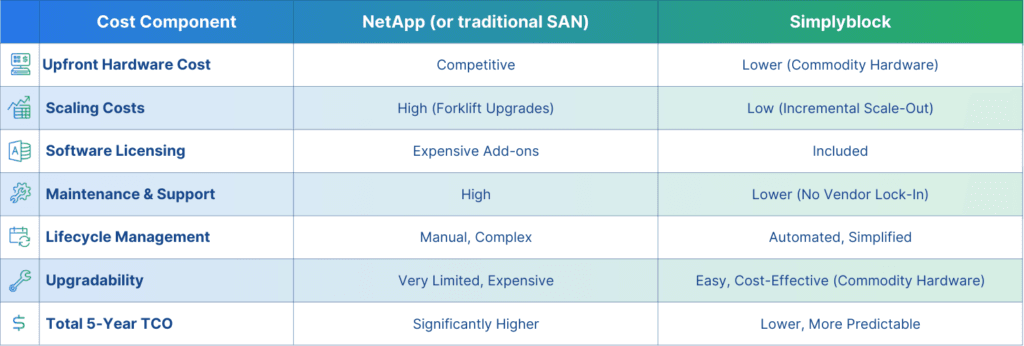
As this comparison shows, while NetApp may appear competitive at first glance, the long-term costs associated with scaling, support, and operations make simplyblock the more cost-effective NetApp replacement.
Cost Calculation Example
Product: AFF-A250A-111-C
24×15.3 TB = 367 TB
100Gbit/s networking
Price: $470.000 (including 12% discount, source: NetApp)
NetApp Revenue Q2 FY 2025 (Source: NetApp):
Product (Hardware): $768 mio
Support: $635 mio
Professional Services: $87 mio
That said, every customer has paid an additional average of 94% of the hardware price in extra services. Hence, the system’s price doubles to just shy of $1.000.000, with the support cost recurring every year, increasing the price per TB even further. To be fair, we assume that after the first year, only 15% additional cost of the hardware’s base price comes on top for support and services, making another $70.000 per annum.
For comparison, a Thomas Krenn server with similar specifications is about $75.000. To make a fair comparison using simplyblock, we’ll create a cluster of smaller servers. A simplyblock cluster needs at least three nodes. Therefore, we’ll use the following system:
Hardware:
System: Thomas Krenn RI1208-AIXSN
Mainboard: Supermicro X13SEI-TF
CPU: Intel Xeon Silver 4509Y
RAM: 128 GB ECC Reg DDR5 560
Storage: 8x 15.36 TB Kiocia CD8-R SIE U.2 NVMe SSD
Network: 100 Gigabit NVIDIA ConnectX-6 Dx EN QSFP56 Dual Port
Unit Price: ~$26.000
Since we need 3 cluster nodes, we end up with a system price of about $78.000 and 368 TB storage capacity.
We also assume an average lifetime of a SAN solution of 4 years. Hence, we need to add simplyblock with a 4-year contract. With those contract details, we calculate $10 / TB for simplyblock. Thus, the simplyblock cost is around $180.000.
With some free space for additional services or some external consultancy, we consider this a $200.000 deal.
Overall, the simplyblock-based solution will cost below $300.000 and is flexibly scalable. If you run out of storage, buying all new hardware is unnecessary—just extend the cluster by an additional node.
| NetApp | Simplyblock + Thomas Krenn | |
|---|---|---|
| Assumed cost over 4 years | > $1.120.000 | < $300.000 |
That said, simplyblock provides the easier scalable solution, with more flexibility, and at less than a quarter of the price.
Why Simplyblock is the Best NetApp Alternative
If you’re considering a NetApp replacement and looking for a software-defined alternative simplyblock offers:
✅ Lower TCO: Reduce long-term costs by eliminating expensive hardware refreshes, support contracts, and licensing fees.
✅ Seamless Scaling: Add capacity without downtime or forklift upgrades.
✅ Software-Defined Flexibility: Run on commodity hardware, avoiding vendor lock-in.
✅ Day 2 Operations Automation: Save time and reduce admin workload with automated data placement, monitoring, and lifecycle management.
✅ Built-in Enterprise-Grade Features: Erasure coding, NVMe tiering, cloud integration, and high availability—without hidden fees.

Make the Smart Switch from NetApp to Simplyblock
Choosing a NetApp alternative isn’t just about upfront cost—it’s about how much your storage solution will cost you in the long run. Simplyblock eliminates high operational costs, vendor lock-in, and lifecycle management challenges with NetApp.
If you’re looking for a modern, scalable, and cost-efficient NetApp replacement, simplyblock delivers a future-proof storage platform that grows with your business—without the headaches of legacy storage systems.
🚀 Ready to explore a NetApp alternative that actually saves you money? Contact simplyblock for a demo today. We offer additional discounts for customers switching from NetApp directly to simplyblock.
Questions and Answers
Software-Defined Storage (SDS) is rapidly gaining traction as it separates storage management from hardware, allowing teams to use cost-efficient, commodity servers instead of proprietary SAN gear. SDS boosts agility, simplifies scaling, and avoids vendor lock-in. It’s an ideal fit for cloud-native and Kubernetes environments—explore how in our SDS use case guide.
Simplyblock’s SDS provides similar or better performance than traditional SAN vendors like NetApp while offering greater scalability and cloud-native integration. Features such as NVMe-over-TCP and Kubernetes-native support allow you to modernize storage infrastructure without proprietary hardware.
NVMe over TCP brings low-latency, high-throughput access to remote storage using standard Ethernet. When integrated into SDS platforms like Simplyblock, it offers up to 35% more IOPS and 25% lower latency compared to iSCSI, making it a clear upgrade for modern applications.
Yes, simplyblock is built with Kubernetes storage in mind. It supports dynamic provisioning via CSI and integrates encryption, replication, and snapshots. This makes it ideal for cloud-native environments running databases, stateful apps, or containerized workloads.
SDS reduces storage TCO by eliminating the need for proprietary hardware and offering flexible scaling. With simplyblock, you can deploy on commodity servers, optimize performance with NVMe, and reduce cloud storage costs through better efficiency and automation.

